Impact of Urban Green Spaces on Social Interaction and Sustainability: A Case Study in Jubail, Saudi Arabia
Abstract
1. Introduction
Literature Review
2. Materials and Methods
2.1. Study Area
2.2. Data Collection and Analysis
2.3. Research Questions and Hypotheses
- How do park design and amenities influence social interaction among diverse groups in Jubail’s neighborhoods?
- What demographic factors (age, gender, nationality) affect park-based social interaction?
- How do safety and accessibility perceptions shape park usage?
2.4. Structure of Survey Questionnaire
3. Results
3.1. Descriptive Analysis
3.2. Analysis of Variance (ANOVA)
3.3. Comparative Analysis
3.3.1. Relationship of Age with Other Variables
3.3.2. Relationship of Gender with Other Variables
3.3.3. Relationship of the Social Interaction with the Nationality
3.3.4. Opinion on Facilities in Parks
4. Discussion
5. Conclusions and Recommendations
- Increase the number of playgrounds, BBQ areas, and food truck spaces to attract diverse user groups and encourage social interaction.
- Improve lighting and safety features, such as fencing and first aid stations, to enhance user comfort and security.
- Incorporate multicultural design elements, such as spaces for intercultural events, to foster inclusivity among diverse residents.
- Plant more trees, particularly native species, in Jalmoudah Park to enhance thermal comfort and support biodiversity, drawing on the success of Riyadh Park’s tree cover [6].
- Develop green alleys or corridors to connect Riyadh Park and Jalmoudah Park with surrounding neighborhoods, improving pedestrian access and ecological connectivity [6].
- Incorporate design strategies inspired by Jan Gehl, such as circular seating arrangements to encourage face-to-face conversations, pedestrian-friendly access to enhance walkability, and flexible urban furniture (e.g., movable seats) to allow users to customize social spaces, fostering spontaneous interactions [13].
5.1. Guidelines for Designers and Officials
- Design Inclusive Spaces: Create flexible, multipurpose areas (e.g., open lawns, amphitheaters) that accommodate diverse activities like cultural festivals, sports, and communal dining, encouraging interactions across nationalities [44].
- Enhance Cultural Representation: Incorporate signage, art installations, or landscaping reflecting Jubail’s multicultural community (e.g., native and regional plant species) to foster a sense of belonging [6].
- Foster Human-Scale Interaction: Use Gehl-inspired elements like clustered seating, low barriers, and clear sightlines to create intimate, welcoming environments that encourage dialogue and reduce cultural barriers [13].
- Engage Communities in Design: Involve residents from varied backgrounds in participatory design processes to ensure that parks reflect local needs and promote shared ownership, aligning with Vision 2030′s community focus [2].
5.2. Contributions to Sustainability
Author Contributions
Funding
Institutional Review Board Statement
Informed Consent Statement
Data Availability Statement
Conflicts of Interest
References
- Catalani, A.; Nour, Z.; Versaci, A.; Hawkes, D.; Bougdah, H.; Sotoca, A.; Ghoneem, M.; Trapani, F.; Catalani, A.; Nour, Z.; et al. Cities’ Identity Through Architecture and Arts; Routledge: Abingdon, UK; CRC Press: Boca Raton, FL, USA, 2018; Available online: https://www.perlego.com/book/1476790/cities-identity-through-architecture-and-arts-proceedings-of-the-international-conference-on-cities-identity-through-architecture-and-arts-citaa-2017-may-1113-2017-cairo-egypt-pdf (accessed on 5 May 2025).
- Maniruzzaman, K.M.; Alqahtany, A.; Abou-Korin, A.; Al-Shihri, F.S. An analysis of residents’ satisfaction with attributes of urban parks in Dammam city, Saudi Arabia. Ain Shams Eng. J. 2021, 12, 3365–3374. [Google Scholar] [CrossRef]
- Alqahtany, A.; Jamil, R. Evaluation of Educational Strategies in the Design Process of Infrastructure for a Healthy Sustainable Housing Community. Ain Shams Eng. J. 2022, 13, 101665. [Google Scholar] [CrossRef]
- Matlovič, R.; Matlovičová, K. The Metamodern Shift in Geographical Thought: Oscillatory Ontology and Epistemology, Post-disciplinary and Post-paradigmatic Perspectives. Folia Geogr. 2025, 67, 22–69. [Google Scholar]
- Storm, J.A.J. Metamodernism: The Future of Theory; The University of Chicago Press: Chicago, IL, USA, 2021; ISBN 978-0-226-78665-0. [Google Scholar]
- Halder, N.; Kumar, M.; Deepak, A.; Mandal, S.K.; Azmeer, A.; Mir, B.A.; Nurdiawati, A.; AlGhamdi, S.G. The Role of Urban Greenery in Enhancing Thermal Comfort: Systematic Review Insights. Sustainability 2025, 17, 2545. [Google Scholar] [CrossRef]
- Zhang, Y.; van Dijk, T.; Tang, J.; van den Berg, A.E. Green Space Attachment and Health: A Comparative Study in Two Urban Neighborhoods. International. J. Environ. Res. Public Health 2015, 12, 14342–14363. [Google Scholar] [CrossRef] [PubMed]
- Vaughan, C.A.; Cohen, D.A.; Han, B. How Do Racial/Ethnic Groups Differ in Their Use of Neighborhood Parks? Findings from the National Study of Neighborhood Parks. J. Urban Health 2018, 95, 739–749. [Google Scholar] [CrossRef]
- RCJ. Jubail Industrial City Guide. 2023. Available online: https://rcj.gov.sa/JicGuide/Beach.html (accessed on 5 May 2025).
- Moulay, A.; Ujang, N. Legibility of neighborhood parks and its impact on social interaction in a planned residential area. ArchNet-IJAR Int. J. Archit. Res. 2016, 10, 184. [Google Scholar] [CrossRef]
- Chen, S.; Sleipness, O.; Christensen, K.; Yang, B.; Park, K.; Knowles, R.; Yang, Z.; Wang, H. Exploring associations between social interaction and urban park attributes: Design guideline for both overall and separate park quality enhancement. Cities 2024, 145, 104714. [Google Scholar] [CrossRef]
- Alnaim, A.; Dano, U.L.; Alqahtany, A.M. Factors Influencing Social Interaction in Recreational Parks in Residential Neighborhoods: A Case Study of the Dammam Metropolitan Area, Saudi Arabia. Sustainability 2025, 17, 3810. [Google Scholar] [CrossRef]
- Gehl, J. Life Between Buildings: Using Public Space; Island Press: Washington, DC, USA, 2011. [Google Scholar]
- Sorana, R. Interior Public Spaces. Addressing the Inside-Outside Interface—Graz University of Technology. SITA—Studii de Istoria si Teoria Arhitecturii. 2017. Available online: https://graz.pure.elsevier.com/en/publications/interior-public-spaces-addressing-the-inside-outside-interface (accessed on 5 May 2025).
- Zhang, R.; Sun, F.; Shen, Y.; Peng, S.; Che, Y. Accessibility of urban park benefits with different spatial coverage: Spatial and social inequity. Appl. Geogr. 2021, 135, 102555. [Google Scholar] [CrossRef]
- Munet-Vilaró, F.; Chase, S.M.; Echeverria, S. Parks as Social and Cultural Spaces Among U.S.- and Foreign-Born Latinas. West. J. Nurs. Res. 2018, 40, 1434–1451. [Google Scholar] [CrossRef]
- Perez, L.G.; Arredondo, E.M.; McKenzie, T.L.; Holguin, M.; Elder, J.P.; Ayala, G.X. Neighborhood Social Cohesion and Depressive Symptoms Among Latinos: Does Use of Community Resources for Physical Activity Matter? J. Phys. Act. Health 2015, 12, 1361–1368. [Google Scholar] [CrossRef]
- Otero Peña, J.E.; Kodali, H.; Ferris, E.; Wyka, K.; Low, S.; Evenson, K.R.; Dorn, J.M.; Thorpe, L.E.; Huang, T.T.K. The Role of the Physical and Social Environment in Observed and Self-Reported Park Use in Low-Income Neighborhoods in New York City. Front. Public Health 2021, 9, 656988. [Google Scholar] [CrossRef] [PubMed]
- Mani, M.; Hosseini, S.M.; Ramayah, T. Parks as business opportunities and development strategies. Bus. Strategy Ser. 2012, 13, 96–101. [Google Scholar] [CrossRef]
- Barreto, P.A.; Lopes, C.S.; da Silveira, I.H.; Faerstein, E.; Junger, W.L. Is living near green areas beneficial to mental health? Results of the Pró-Saúde Study. Rev. Saúde Pública 2019, 53, 75. [Google Scholar] [CrossRef] [PubMed]
- Leung, A.K.Y.; Maddux, W.W.; Galinsky, A.D.; Chiu, C.Y. Multicultural Experience Enhances Creativity: The When and How. Am. Psychol. 2008, 63, 169–181. [Google Scholar] [CrossRef] [PubMed]
- Jayadi, K.; Abduh, A.; Basri, M. A meta-analysis of multicultural education paradigm in Indonesia. Heliyon 2022, 8, e08828. [Google Scholar] [CrossRef]
- Sudigdo, A.; Pamungkas, O.Y. Multiculturalism in Children’s Literature: A Study of a Collection of Poems by Elementary School Students in Yogyakarta. Daengku J. Humanit. Soc. Sci. Innov. 2022, 2, 266–278. [Google Scholar] [CrossRef]
- Mena, J.A.; Rogers, M.R. Factors associated with multicultural teaching competence: Social justice orientation and multicultural environment. Train. Educ. Prof. Psychol. 2017, 11, 61–68. [Google Scholar] [CrossRef]
- Turna, N.; Bhandari, H. Role of Parks as Recreational Spaces at Neighborhood Level in Indian Cities. ECS Trans. 2022, 107, 8685–8694. [Google Scholar] [CrossRef]
- Xu, J.; Wang, F.; Chen, L.; Zhang, W. Perceived urban green and residents’ health in Beijing. SSM—Popul. Health 2021, 14, 100790. [Google Scholar] [CrossRef] [PubMed]
- Ramezani Mehrian, M.; Manouchehri Miandoab, A.; Abedini, A.; Aram, F. The Impact of Inefficient Urban Growth on Spatial Inequality of Urban Green Resources (Case Study: Urmia City). Resources 2022, 11, 62. [Google Scholar] [CrossRef]
- Raap, S.; Knibbe, M.; Horstman, K. Clean Spaces, Community Building, and Urban Stage: The Coproduction of Health and Parks in Low-Income Neighborhoods. J. Urban Health 2022, 99, 680–687. [Google Scholar] [CrossRef]
- Vaeztavakoli, A.; Lak, A.; Yigitcanlar, T. Blue and Green Spaces as Therapeutic Landscapes: Health Effects of Urban Water Canal Areas of Isfahan. Sustainability 2018, 10, 4010. [Google Scholar] [CrossRef]
- Ulset, V.; Venter, Z.; Charlott, E.; Nordbø, A. Increased nationwide recreational mobility in green spaces in Norway during the COVID-19 pandemic. Environ. Int. 2023, 180, 108190. [Google Scholar] [CrossRef] [PubMed]
- Chen, X.; Kang, J. Natural sounds can encourage social interactions in urban parks. Landsc. Urban Plan. 2023, 239, 104870. [Google Scholar] [CrossRef]
- Sun, Y.; Tan, S.; He, Q.; Shen, J. Influence Mechanisms of Community Sports Parks to Enhance Social Interaction: A Bayesian Belief Network Analysis. Int. J. Environ. Res. Public Health 2022, 19, 1466. [Google Scholar] [CrossRef]
- Cui, H.; Maliki, N.Z.; Wang, Y. The Role of Urban Parks in Promoting Social Interaction of Older Adults in China. Sustainability 2024, 16, 2088. [Google Scholar] [CrossRef]
- Cohen, D.A.; Han, B.; Williamson, S.; Nagel, C.; McKenzie, T.L.; Evenson, K.R.; Harnik, P. Playground features and physical activity in U.S. neighborhood parks. Prev. Med. 2020, 131, 105945. [Google Scholar] [CrossRef]
- Poppe, L.; Van Dyck, D.; De Keyser, E.; Van Puyvelde, A.; Veitch, J.; Deforche, B. The impact of renewal of an urban park in Belgium on park use, park-based physical activity, and social interaction: A natural experiment. Cities 2023, 140, 104428. [Google Scholar] [CrossRef]
- Wolch, J.; Wilson, J.P.; Fehrenbach, J. Parks and park funding in Los Angeles: An equity-mapping analysis. Urban Geogr. 2005, 26, 4–35. [Google Scholar] [CrossRef]
- Peters, K.; Elands, B.; Buijs, A. Social interactions in urban parks: Stimulating social cohesion? Urban For. Urban Green. 2010, 9, 93–100. [Google Scholar] [CrossRef]
- Whiting, J.W.; Larson, L.R.; Green, G.T.; Kralowec, C. Outdoor recreation motivation and site preferences across diverse racial/ethnic groups: A case study of Georgia state parks. J. Outdoor Recreat. Tour. 2017, 18, 10–21. [Google Scholar] [CrossRef]
- Dade, M.C.; Mitchell, M.G.E.; Brown, G.; Rhodes, J.R. The effects of urban greenspace characteristics and socio-demographics vary among cultural ecosystem services. Urban For. Urban Green. 2020, 49, 126641. [Google Scholar] [CrossRef]
- Rivera, E.; Veitch, J.; Loh, V.H.Y.; Salmon, J.; Cerin, E.; Mavoa, S.; Villanueva, K.; Timperio, A. Outdoor public recreation spaces and social connectedness among adolescents. BMC Public Health 2022, 22, 165. [Google Scholar] [CrossRef] [PubMed]
- Jennings, V.; Bamkole, O. The Relationship between Social Cohesion and Urban Green Space: An Avenue for Health Promotion. Int. J. Environ. Res. Public Health 2019, 16, 452. [Google Scholar] [CrossRef]
- Schmidt, T.; Kerr, J.; Schipperijn, J. Associations between Neighborhood Open Space Features and Walking and Social Interaction in Older Adults—A Mixed Methods Study. Geriatrics 2019, 4, 41. [Google Scholar] [CrossRef]
- Rivera, E.; Timperio, A.; Loh, V.H.; Deforche, B.; Veitch, J. Important Park features for encouraging park visitation, physical activity and social interaction among adolescents: A conjoint analysis. Health Place 2021, 70, 102617. [Google Scholar] [CrossRef]
- Powers, S.L.; Webster, N.; Agans, J.P.; Graefe, A.R.; Mowen, A.J. The power of parks: How interracial contact in urban parks can support prejudice reduction, interracial trust, and civic engagement for social justice. Cities 2022, 131, 104032. [Google Scholar] [CrossRef]
- Rio, C.J.; Saligan, L.N. Understanding physical activity from a cultural-contextual lens. Front. Public Health 2023, 11, 1223919. [Google Scholar] [CrossRef]
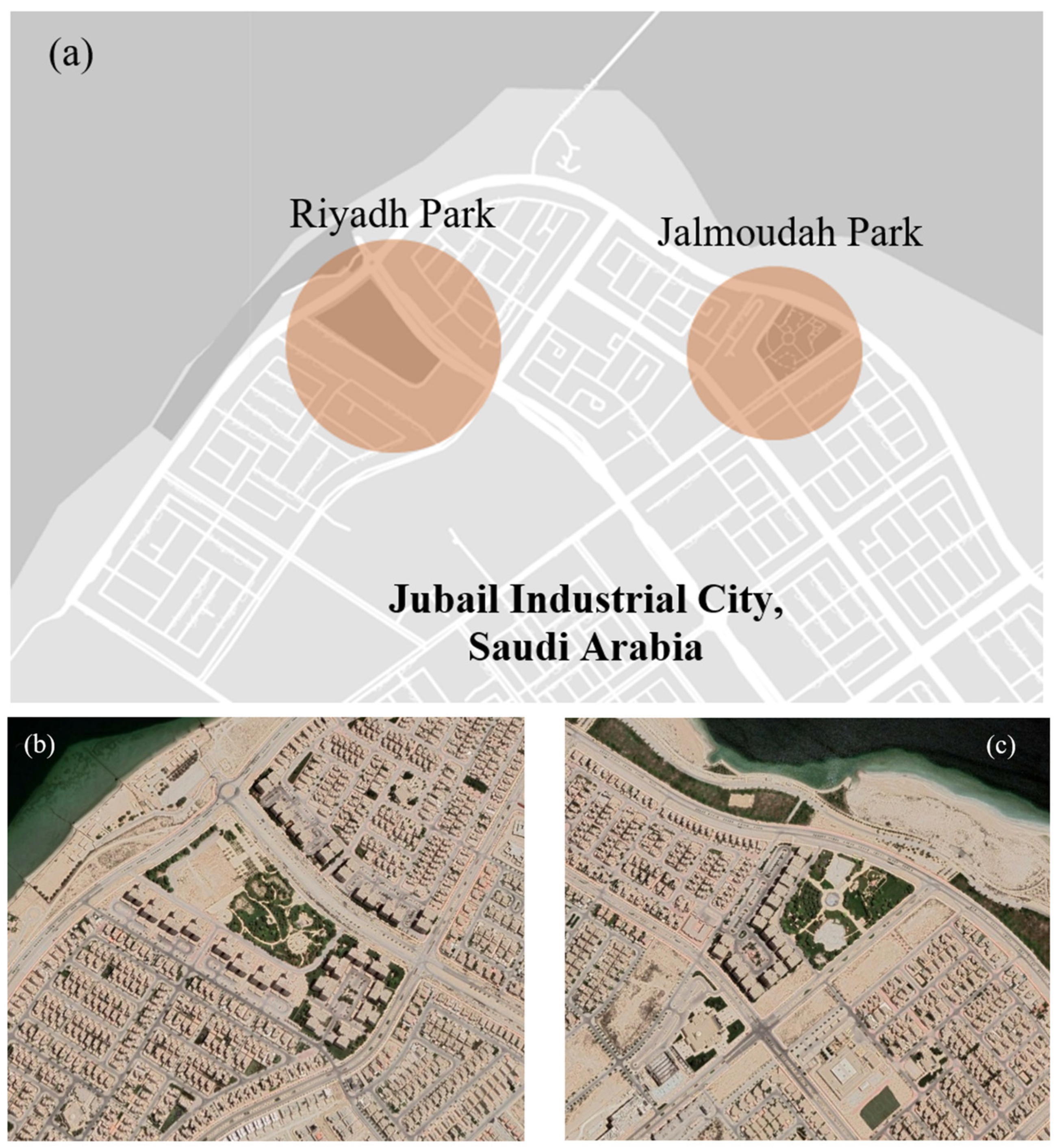
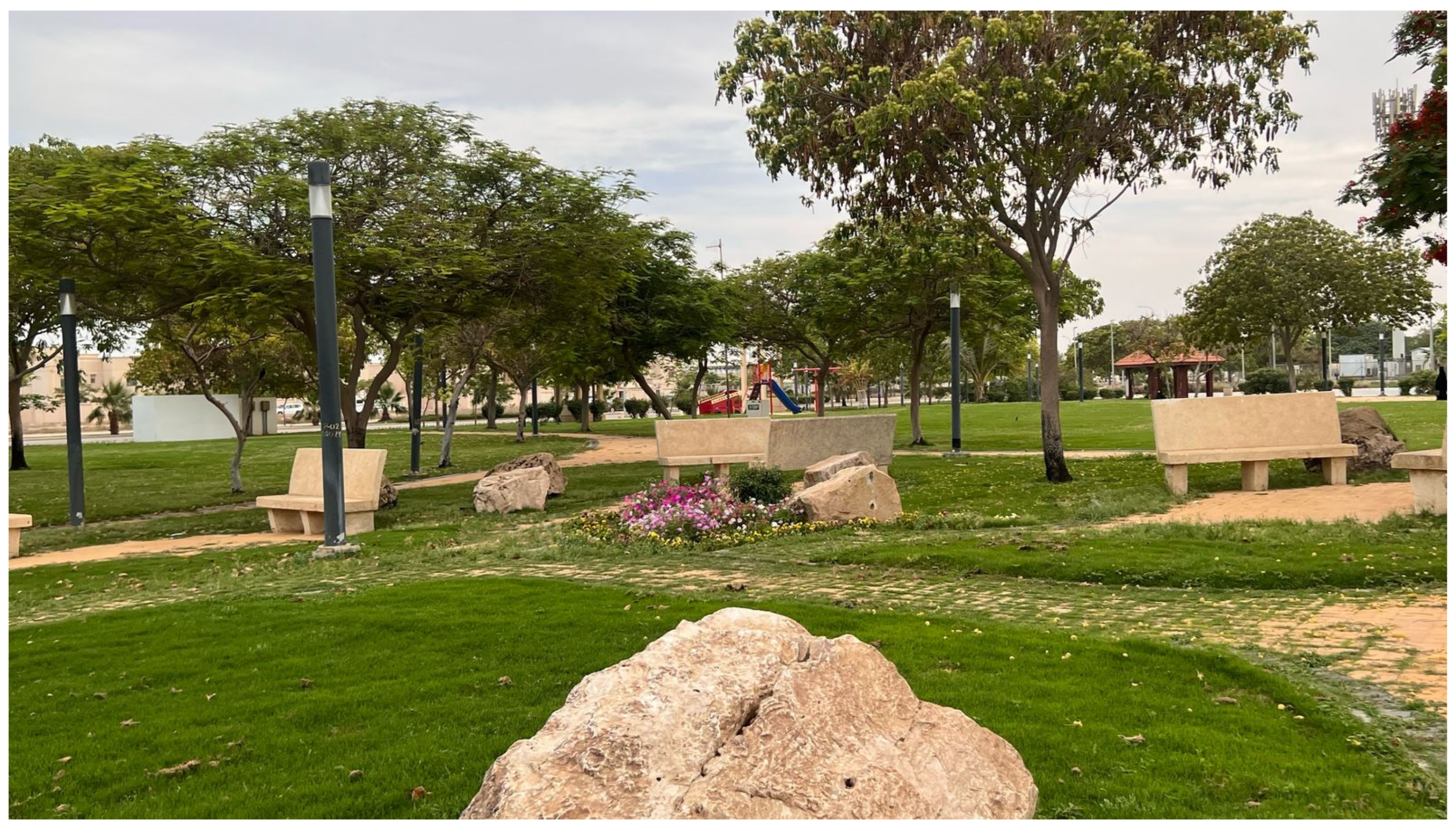
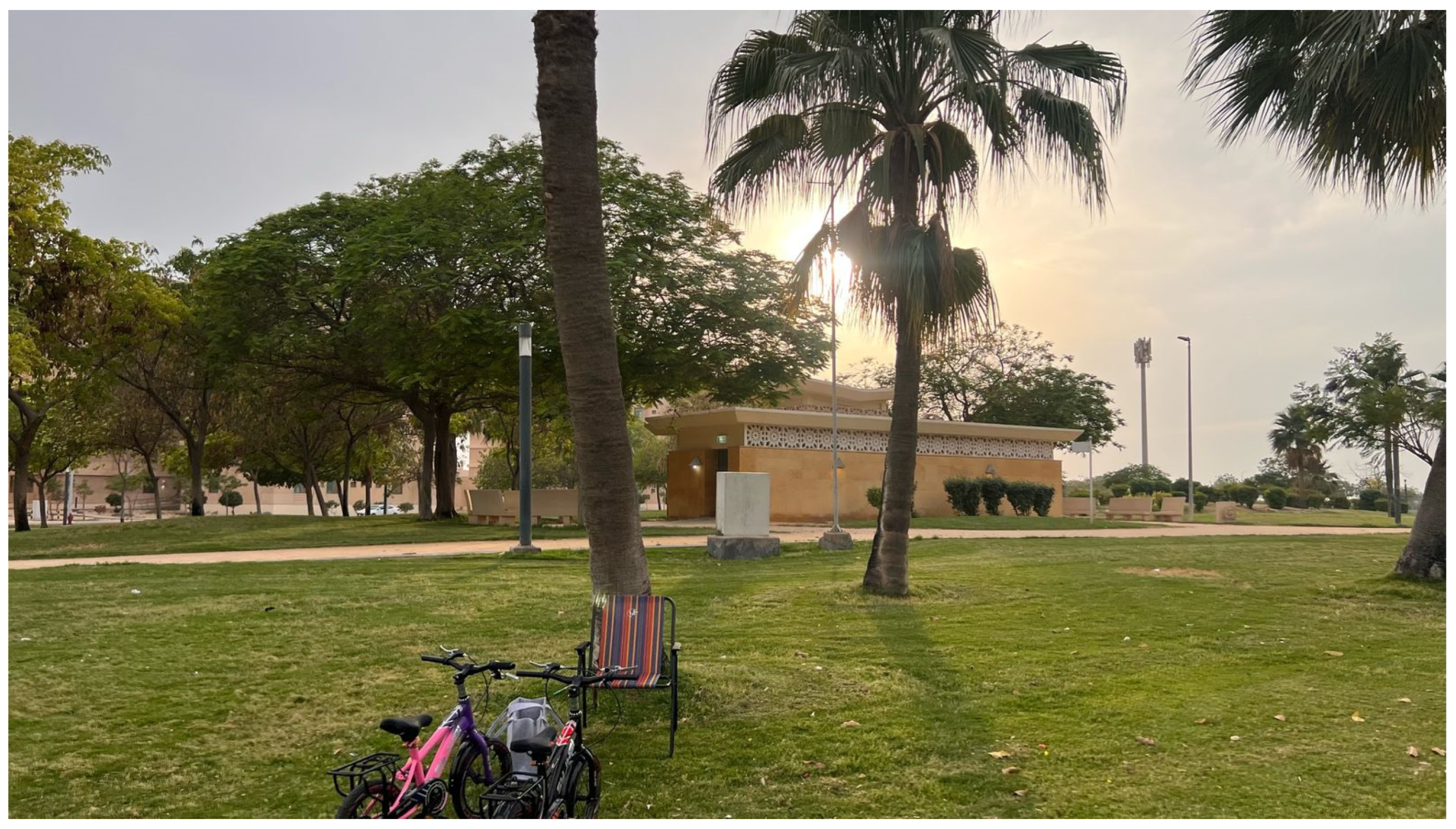
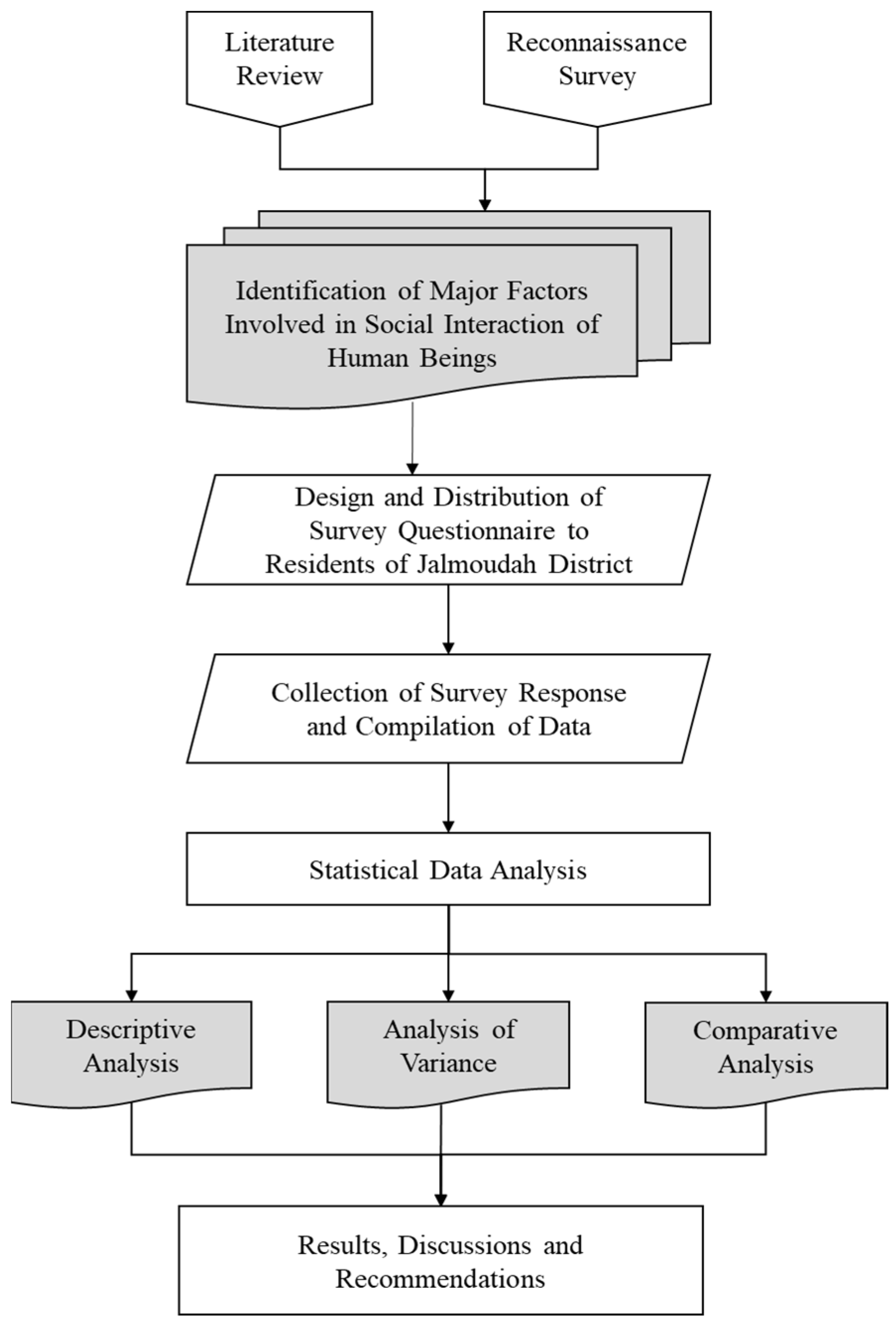

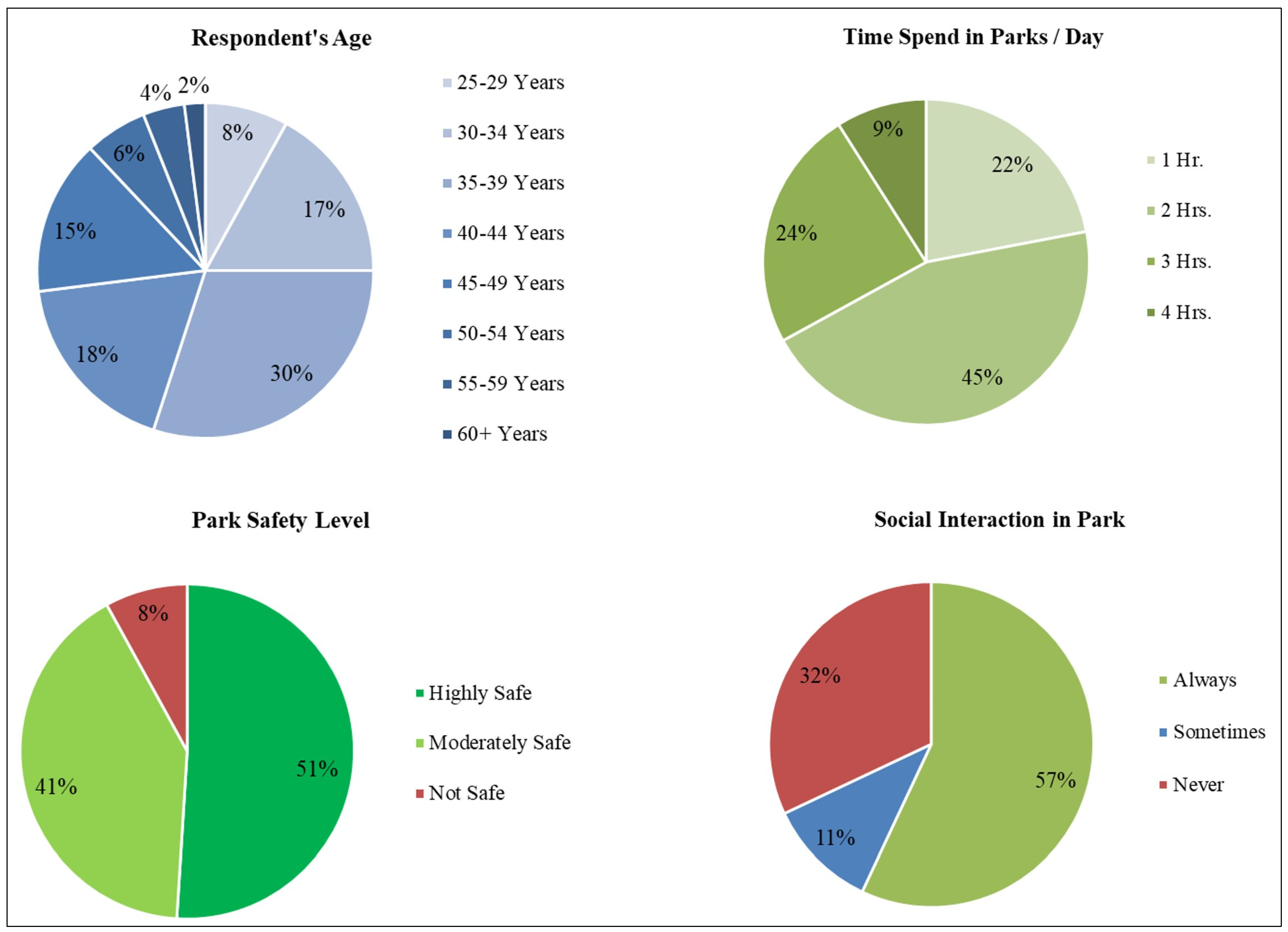
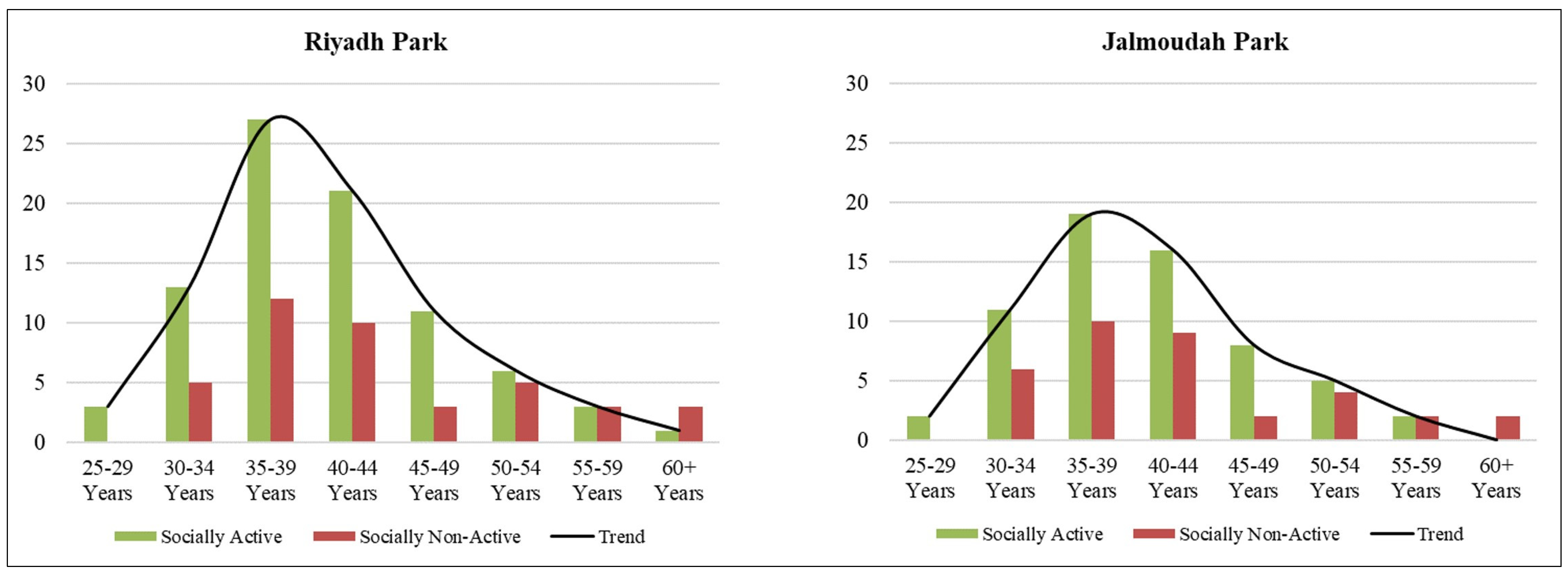



| Category | Options | Type |
|---|---|---|
| Mode of Transport | Bus, Car, Bicycle/Scooter, Walking | Check Box |
| Purpose of Visit | Relaxation, Spending time with the family, Kids Entertainment and Activities, Physical Activities, Working Out/Walk, Neighbors Gathering, Meeting New People | |
| Preference of Season | Summer, Autumn, Winter, Spring | |
| Time of Visit | Morning, Afternoon, Evening | |
| Duration of Stay | 1, 2, 3, or 4 h | |
| Company | Alone, Friends, Family | |
| Frequency of Visit | Daily, Once/Twice/Thrice a Week, Rarely | Multiple Choice |
| Number of Times Meeting in a Group | Daily, Weekly, Bi-Weekly, Monthly, Never | |
| Meeting with Other Nationalities | Yes, No |
| Category | Options | Type |
|---|---|---|
| Facilities for people with special needs (e.g., ramps, parking, toilets, sitting areas) | 1 to 5 | Likert Scale |
| Level of Facilities in Parks | Poor, Good, Very Good | Multiple Choice |
| Level of Satisfaction | 1 to 5 | Likert Scale |
| Required Improvements | Increase in the number of playgrounds, Separate Path for Walking/Jogging and Cycling, Provision of Food Trucks, Places for BBQ and Cooking, Lighting during Evening and Night | Check box |
| Safety of Children and People | 1 to 5 | Likert Scale |
| Safety Factors Required in Park | Text | Open Ended Question |
| Parameter | Response Mean ( ) | Average Value | Response Standard Deviation (σ) |
|---|---|---|---|
| Age Bracket | 3.29/5 | 39 Years | 0.82 |
| Time Spent in Parks/Day | 2.63/4 | 2–3 h | 0.89 |
| Park Safety Level | 4.27/5 | Highly to Moderately Safe | 0.90 |
| Social Interaction in Park | 2.18/4 | Always to Sometimes | 0.49 |
| ANOVA | |||||||
|---|---|---|---|---|---|---|---|
| Sources | SS | df | F | p Value | F Crit | RMSSE | Omega Sq |
| Between Groups | 537.2943 | 6 | 194.4529 | 9.8 × 10−135 | 2.114359 | 1.530623 | 0.666421 |
| Within Groups | 264.3373 | 574 | |||||
| Total | 801.6317 | 580 |
| Group 1 | Group 2 | Mean | Std Err | q-Stat | Lower | Upper | p-Value | Mean-Crit | Cohen d |
|---|---|---|---|---|---|---|---|---|---|
| Age | Gender | 1.7470 | 0.0745 | 23.4534 | 1.4364 | 2.0576 | −2.2 × 10−14 | 0.3106 | 2.5743 |
| Age | Nationality | 1.6265 | 0.0745 | 21.8359 | 1.3159 | 1.9371 | −2.2 × 10−14 | 0.3106 | 2.3968 |
| Age | Park Location | 2.0000 | 0.0745 | 26.8501 | 1.6894 | 2.3106 | −2.2 × 10−14 | 0.3106 | 2.9472 |
| Age | Social Interaction | 1.8795 | 0.0745 | 25.2326 | 1.5689 | 2.1901 | −2.2 × 10−14 | 0.3106 | 2.7696 |
| Age | Time Spent | 1.0723 | 0.0745 | 14.3955 | 0.7617 | 1.3829 | −2.2 × 10−14 | 0.3106 | 1.5801 |
| Age | Safety | 0.6747 | 0.0745 | 9.0579 | 0.3641 | 0.9853 | 6.57 × 10−9 | 0.3106 | 0.9942 |
| Gender | Nationality | 0.1205 | 0.0745 | 1.6175 | −0.1901 | 0.4311 | 0.914228 | 0.3106 | 0.1775 |
| Gender | Park Location | 0.2530 | 0.0745 | 3.3967 | −0.0576 | 0.5636 | 0.199588 | 0.3106 | 0.3728 |
| Gender | Social Interaction | 0.1325 | 0.0745 | 1.7792 | −0.1781 | 0.4431 | 0.870594 | 0.3106 | 0.1953 |
| Gender | Time Spent | 0.6747 | 0.0745 | 9.0579 | 0.3641 | 0.9853 | 6.57 × 10−9 | 0.3106 | 0.9942 |
| Gender | Safety | 2.4217 | 0.0745 | 32.5113 | 2.1111 | 2.7323 | −2.2 × 10−14 | 0.3106 | 3.5686 |
| Nationality | Park Location | 0.3735 | 0.0745 | 5.0142 | 0.0629 | 0.6841 | 0.007692 | 0.3106 | 0.5504 |
| Nationality | Social Interaction | 0.2530 | 0.0745 | 3.3967 | −0.0576 | 0.5636 | 0.199588 | 0.3106 | 0.3728 |
| Nationality | Time Spent | 0.5542 | 0.0745 | 7.4404 | 0.2436 | 0.8648 | 4.2 × 10−6 | 0.3106 | 0.8167 |
| Nationality | Safety | 2.3012 | 0.0745 | 30.8938 | 1.9906 | 2.6118 | −2.2 × 10−14 | 0.3106 | 3.3910 |
| Park Location | Social Interaction | 0.1205 | 0.0745 | 1.6175 | −0.1901 | 0.4311 | 0.914228 | 0.3106 | 0.1775 |
| Park Location | Time Spent | 0.9277 | 0.0745 | 12.4546 | 0.6171 | 1.2383 | −2.2 × 10−14 | 0.3106 | 1.3671 |
| Park Location | Safety | 2.6747 | 0.0745 | 35.9079 | 2.3641 | 2.9853 | −2.2 × 10−14 | 0.3106 | 3.9414 |
| Social Interaction | Time Spent | 0.8072 | 0.0745 | 10.8371 | 0.4966 | 1.1178 | 1.61 × 10−12 | 0.3106 | 1.1895 |
| Social Interaction | Safety | 2.5542 | 0.0745 | 34.2905 | 2.2436 | 2.8648 | −2.2 × 10−14 | 0.3106 | 3.7639 |
| Time Spent | Safety | 1.7470 | 0.0745 | 23.4534 | 1.4364 | 2.0576 | −2.2 × 10−14 | 0.3106 | 2.5743 |
Disclaimer/Publisher’s Note: The statements, opinions and data contained in all publications are solely those of the individual author(s) and contributor(s) and not of MDPI and/or the editor(s). MDPI and/or the editor(s) disclaim responsibility for any injury to people or property resulting from any ideas, methods, instructions or products referred to in the content. |
© 2025 by the authors. Licensee MDPI, Basel, Switzerland. This article is an open access article distributed under the terms and conditions of the Creative Commons Attribution (CC BY) license (https://creativecommons.org/licenses/by/4.0/).
Share and Cite
Alshehri, R.M.; Alzenifeer, B.M.; Alqahtany, A.M.; Alrawaf, T.; Alsayed, A.H.; Afify, H.M.N.; Elmoghazy, Z.A.A.; Alshammari, M.S. Impact of Urban Green Spaces on Social Interaction and Sustainability: A Case Study in Jubail, Saudi Arabia. Sustainability 2025, 17, 4467. https://doi.org/10.3390/su17104467
Alshehri RM, Alzenifeer BM, Alqahtany AM, Alrawaf T, Alsayed AH, Afify HMN, Elmoghazy ZAA, Alshammari MS. Impact of Urban Green Spaces on Social Interaction and Sustainability: A Case Study in Jubail, Saudi Arabia. Sustainability. 2025; 17(10):4467. https://doi.org/10.3390/su17104467
Chicago/Turabian StyleAlshehri, Roaa M., Badran M. Alzenifeer, Ali M. Alqahtany, Tareq Alrawaf, Aymen H. Alsayed, Hazem M. Nour Afify, Zeinab Ahmed AbdElghaffar Elmoghazy, and Maher S. Alshammari. 2025. "Impact of Urban Green Spaces on Social Interaction and Sustainability: A Case Study in Jubail, Saudi Arabia" Sustainability 17, no. 10: 4467. https://doi.org/10.3390/su17104467
APA StyleAlshehri, R. M., Alzenifeer, B. M., Alqahtany, A. M., Alrawaf, T., Alsayed, A. H., Afify, H. M. N., Elmoghazy, Z. A. A., & Alshammari, M. S. (2025). Impact of Urban Green Spaces on Social Interaction and Sustainability: A Case Study in Jubail, Saudi Arabia. Sustainability, 17(10), 4467. https://doi.org/10.3390/su17104467







